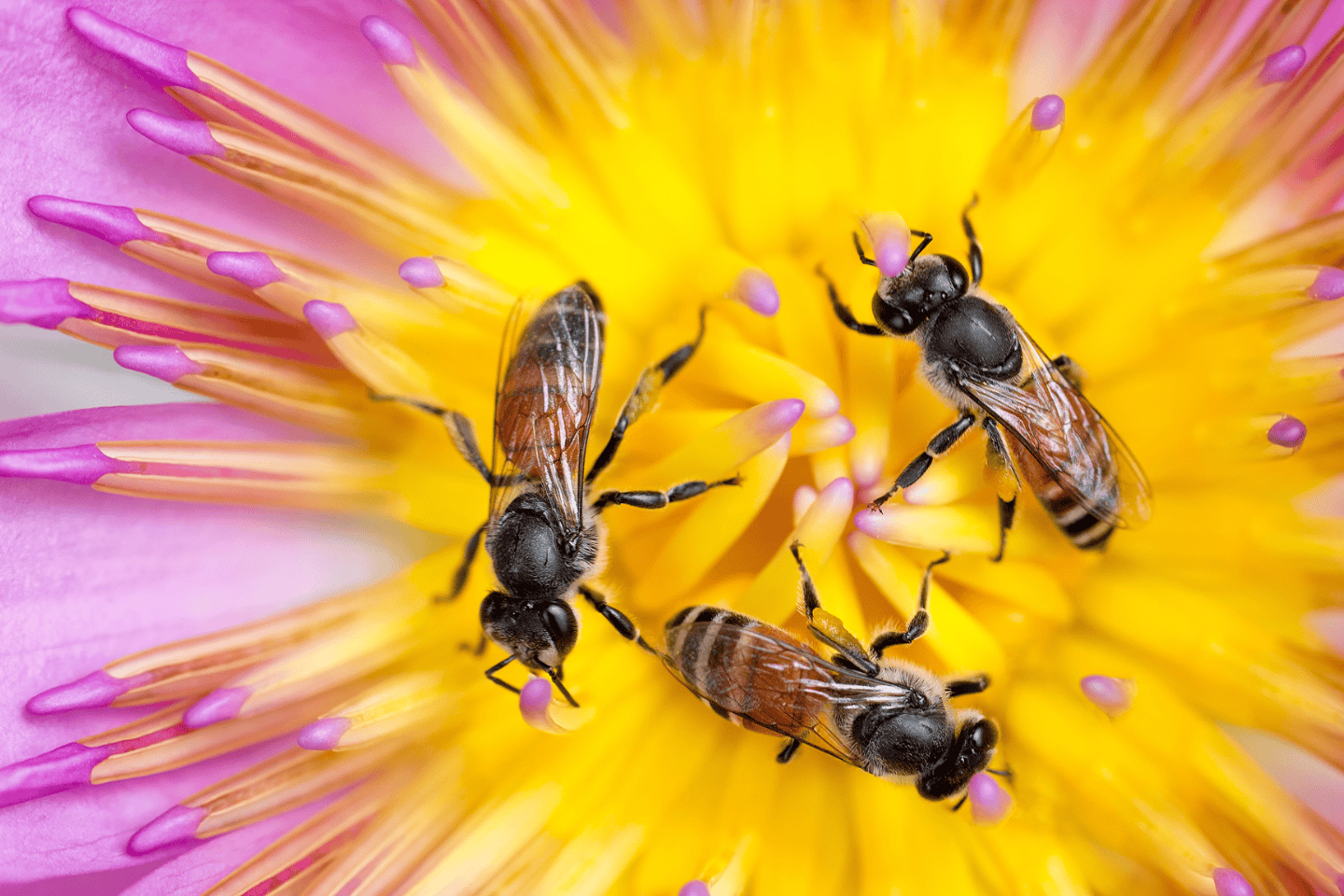The Buzz About Bees: Why They Matter and How You Can Help

From the vibrant wildflower fields to the produce aisles of our grocery stores, bees have a hand—or rather, a wing—in shaping our world. Despite their small size, these hardworking insects play an enormous role in maintaining the health of our ecosystems and supporting global agriculture. However, in recent years, bee populations have been on the decline due to various factors, posing a significant threat to biodiversity and food security. In this blog, we’ll dive into the fascinating world of bees, explore their historical significance, understand their crucial roles, and discuss practical ways you can contribute to their protection and preservation.
A Brief History of Bees: From Prehistoric Times to the Present
Bees have been buzzing around for millions of years, long before humans walked the earth. The earliest bee fossils date back approximately 100 million years to the mid-Cretaceous period. These ancient bees likely evolved alongside flowering plants (angiosperms), forming a mutually beneficial relationship that has persisted throughout evolutionary history.
In ancient cultures, bees were revered and celebrated for their industrious nature and the sweet nectar they produced—honey. The ancient Egyptians kept bees and were among the first known beekeepers. Hieroglyphs and artifacts from as early as 2400 BCE depict beekeeping and honey extraction practices, highlighting the value of bees in Egyptian society. Honey was used not only as a sweetener but also for medicinal and religious purposes.
Similarly, in Greek mythology, bees were associated with the goddess Artemis and were considered symbols of fertility and abundance. Aristotle, the Greek philosopher, wrote extensively about bees and their behavior in his treatise History of Animals. His observations, though not always accurate, reflect the profound interest in these creatures and their societal value.
Fast forward to medieval Europe, bees and honey became even more essential. Honey was one of the only available sweeteners before the advent of sugar cane, and beeswax was a crucial component in candle-making, which illuminated homes, churches, and monasteries.
Today, despite our technological advancements, the importance of bees has not diminished. If anything, it has increased. Yet, despite our reliance on these tiny pollinators, bee populations are facing unprecedented challenges.
The Vital Role of Bees in Ecosystems and Agriculture
Prolific Pollinators
Bees are among the world’s most efficient pollinators. As they forage for nectar and pollen, they transfer pollen grains from the male anthers of a flower to the female stigma, enabling fertilization and the production of fruits, seeds, and flowers. This process is critical for the reproduction of over 75% of flowering plants, including many of the fruits, vegetables, and nuts we rely on.
Without bees, crops such as apples, blueberries, cherries, avocados, almonds, and tomatoes would see a dramatic decline in yields. The economic value of pollination by bees is staggering, contributing an estimated $15 billion annually to the U.S. economy alone, according to the U.S. Department of Agriculture. Globally, the value is estimated to be in the hundreds of billions of dollars.
Beyond agriculture, bees also support the survival of wild plant species. Many native plants rely solely on bee pollination to reproduce. This interdependence fosters biodiversity, which in turn provides habitat and food for other wildlife species. Thus, bees contribute to the complex web of life, supporting a multitude of organisms within ecosystems.
Ecological Engineers
Bees are more than just pollinators; they are ecological engineers. By supporting the growth of flowering plants, bees help stabilize soils, prevent erosion, and regulate the carbon cycle. The plants they pollinate provide shelter and food for countless animals, create microhabitats, and influence the distribution and health of other plant species. Without bees, the very structure of many ecosystems would be in jeopardy.
The Decline of Bee Populations: What’s Happening?
In recent decades, bee populations have been declining at an alarming rate. Some species, like the rusty patched bumblebee, have been listed as endangered, while others, such as the honeybee, have experienced dramatic reductions in colony numbers. Several factors contribute to this decline:
Urbanization, industrial agriculture, and deforestation have reduced the availability of wildflower meadows and nesting sites, forcing bees out of their natural habitats.
Pesticides like neonicotinoids disrupt bees’ nervous systems and impair their ability to forage, navigate, and reproduce—even at sub-lethal doses.
Shifting temperatures affect blooming times and disrupt bees' foraging patterns, reproduction, and access to water and food sources.
Pathogens like the Varroa mite and fungal infections weaken bee immune systems and devastate entire colonies, especially when combined with other stressors.
Why the Loss of Bees Matters
The loss of bees extends far beyond the agricultural and economic implications. A decline in bee populations threatens food security, as many of the crops they pollinate are dietary staples. Additionally, the disappearance of bees could trigger a domino effect in ecosystems, disrupting plant and animal communities that rely on these pollinators. This loss of biodiversity can ultimately lead to the degradation of ecosystems and the services they provide, such as clean air, water, and fertile soil.
How You Can Help Protect Bees
While the challenges facing bees are significant, there is hope. Everyone, from individuals to communities and businesses, can play a role in protecting and supporting bee populations. Here’s how you can contribute:
1. Plant a Bee-Friendly Garden
One of the simplest ways to support bees is to plant a garden filled with bee-friendly flowers and herbs. Choose native plants that bloom at different times of the year to provide bees with a continuous source of nectar and pollen. Some great options include:
2. Avoid Using Pesticides
Chemical pesticides are one of the leading threats to bee populations. If you need to control pests, opt for organic or natural alternatives. Introducing beneficial insects like ladybugs or using homemade insecticidal soap can be effective without harming bees.
3. Provide Water Sources
Bees need water just like any other living creature. You can help by placing a shallow dish filled with water and pebbles in your garden. The pebbles provide a landing spot for bees to rest and drink safely without drowning.
4. Support Organic and Sustainable Farming
When you buy organic and sustainably farmed produce, you support agricultural practices that are less harmful to bees and other pollinators. Organic farms tend to have more diverse plant species and fewer harmful chemicals, creating a safer environment for bees.
5. Create Bee Habitats
Consider installing a bee hotel in your garden. Bee hotels provide solitary bees, which make up the majority of bee species, with safe nesting sites. Leave a small patch of your yard uncultivated or covered with natural debris to create a habitat for ground-nesting bees as well.
6. Support Local Beekeepers
Buying honey and beeswax products from local beekeepers supports beekeeping efforts and helps maintain healthy bee populations. Local beekeepers often implement sustainable practices that prioritize the well-being of bees and their environment.
7. Advocate for Bee Protection Policies
Raise your voice for bees by supporting policies that protect pollinators and their habitats. Advocate for the reduction of pesticide use, the protection of natural areas, and the establishment of more green spaces in urban environments.
Fun Facts About Bees: Beyond the Buzz
To truly appreciate the value of bees, it helps to understand some of their fascinating behaviors and characteristics:
- 🐝 Bees Have Been Making Honey for 150 Million Years: Honeybees have been producing honey long before humans started harvesting it.
- 🐝 A Single Bee Colony Can Pollinate 300 Million Flowers Daily: This shows just how crucial bees are for maintaining our ecosystems and food supply.
- 🐝 Bees Communicate Through Dance: Known as the “waggle dance,” bees use this movement to share information about the location and quality of food sources.
- 🐝 Different Bee Species Have Different Tongue Lengths: This adaptation allows them to access nectar from flowers of varying shapes and sizes, promoting a diverse ecosystem.
- 🐝 Bees Are the Only Insects That Produce Food Eaten by Humans: Honey is the only insect-made food we consume — a sweet reminder of how special our connection to bees really is.
The Future of Bees and Our Responsibility
Protecting bees is not just about safeguarding a single species—it’s about preserving our planet’s biodiversity and ensuring food security for future generations. The decline of bee populations serves as a warning that our ecosystems are in peril. Yet, with increased awareness and collective action, we can turn the tide.
Bees are essential to the health of our environment and food systems. Their decline is a global issue that requires a unified response from individuals, communities, and policymakers. By planting bee-friendly gardens, avoiding harmful pesticides, supporting sustainable agriculture, and advocating for bee protection, we can all contribute to reversing the decline of bee populations. Together, we can create a future where bees continue to thrive, pollinate, and sustain the delicate balance of our ecosystems.
Let’s celebrate these remarkable creatures and do our part to protect them—because when bees thrive, we all benefit.

Jana Taylor is an Iowa native and seasoned copy writer, content creator and designer, specializing in marketing and graphic design since 2015. In her spare time, she volunteers in her community, loves to garden and is an avid travel enthusiast.
References
https://www.fws.gov/story/2023-09/save-pollinators-save-planet
https://www.fs.usda.gov/managing-land/wildflowers/pollinators/importance
https://www.nationalgeographic.com/animals/invertebrates/facts/honeybee (Sign in needed)
https://www.britannica.com/animal/honeybee
https://www.ucsusa.org/resources/sustainable-agriculture-practices
https://www.nrdc.org/stories/neonicotinoids-101-effects-humans-and-bees
https://xerces.org/pollinator-conservation
https://www.unep.org/news-and-stories/story/why-bees-are-essential-people-and-planet
https://thebeeconservancy.org/why-bees/
https://www.worldwildlife.org/stories/why-bees-are-climate-heroes










